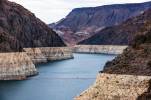Coyote Springs’ water rights case argued before Nevada Supreme Court
The fate of the long-stalled Coyote Springs community may rest on whether the state engineer overstepped his authority in trying to protect a 4-inch-long endangered fish found only in the Nevada desert.
The Nevada Supreme Court on Tuesday heard oral arguments in the lengthy battle over water rights for the master-planned community some 60 miles north of Las Vegas in a case that could set significant precedent for how the driest state in the nation manages the precious resource.
At issue in the case is whether the state engineer, who is tasked with regulating water rights throughout Nevada, had the authority to manage the multiple aquifers that make up the Lower White River Flow System as a single basin. The state made the decision to do so in an attempt to protect the habitat of the endangered Moapa dace.
If the high court were to reverse a lower court’s ruling, it would mark a major blow to Coyote Springs, a planned community of nearly 160,000 homes that’s been in the works for more than two decades but has yet to see a single home built.
Coyote Springs Investment sued the state in 2020 after the state engineer denied plans for the developer to build new homes at Coyote Springs, ruling that pumping groundwater above a certain threshold could one day dry up springs that are home to the Moapa dace, which is found only in the headwaters of the Muddy River.
A district judge sided with Coyote Springs last year, ruling that the state engineer’s decision was made arbitrarily. The state appealed the ruling.
State attorneys argued Tuesday that because the combined basins share a singular water source, they should be managed together to prevent pumping more water than the total system can sustain.
“If you’re pulling in one basin, you’re affecting the entire system,” Chief Deputy Solicitor General Jeffrey Conner said during Tuesday’s hearing.
While the justices did not indicate when a decision would be made or which way they may be leaning, most of the questions were directed at Coyote Springs’ lawyers.
Attorneys for the developer argued that the state engineer lacks the authority to combine basins and that doing so would upend the certainty of already established water rights.
Kent Robison, an attorney representing Coyote Springs, said the 2020 decision shifted the developers from first in the priority line for water rights in their basin to 57th in the combined basin.
If the state engineer were to impose a cap of 8,000 acre-feet of pumping from the combined basin, “we have no water,” Robison said.
“Doesn’t that mean that the first 56 had rights prior to your client’s rights, and that if your client uses your client’s rights then it will infringe or make the more senior people not be able to use the amount of water they should be able to use?” Justice Elissa Cadish asked.
Robison said that would only happen if a conflict over such rights were to occur.
“What happened here is that the statutes were construed to allow combining seven basins, even though priority and senior water rights are affixed to singular basins,” the attorney said.
The case is likely to have far-reaching implications for the future of water rights in Nevada beyond just Coyote Springs, as evidenced by the 18 different parties involved in the lawsuit, including other water users and water brokers, municipal governments, mining interests, power companies and even the Southern Nevada Water Authority.
The water authority has rights to roughly 20,000 acre-feet of water in the Lower White River Flow System, the agency’s attorney Paul Taggart said, including water that flows into the Colorado River and eventually to Lake Mead.
Contact Colton Lochhead at clochhead@reviewjournal.com. Follow @ColtonLochhead on Twitter.





























